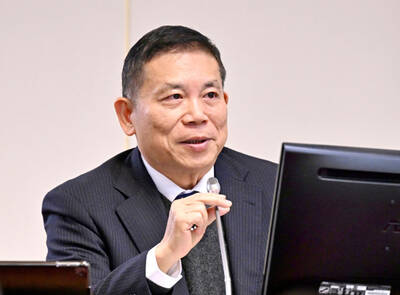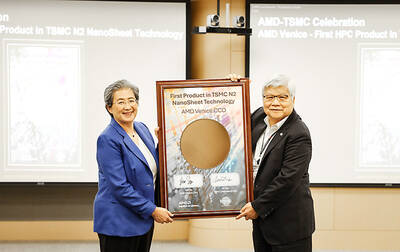Smartphone maker HTC Corp (宏達電) yesterday launched its first 4G entry-level smartphone in the domestic market, with an eye to seizing 25 percent of the low-price market segment this year.
HTC has previously resisted entering this market, and its market share has dwindled as more affordable models prevailed over premium ones.
The firm had never launched a 4G smartphone priced at about NT$5,000 (US$158.42) in Taiwan before, HTC North Asia president Jack Tong (董俊良) said, but it is hopeful that the new handset can help it reach its goal of selling more than 375,000 4G and 3G entry-level smartphones in the nation this year.

Photo: Wu Pei-hua, Taipei Times
That translates into about a quarter of the nation’s low-price smartphone market of 1.5 million units this year, Tong said.
“Following our success in selling the mid-range smartphone Desire 816 and partnerships with local telecom operators and retailers, we believe that our new entry-level 4G model has a chance to help us achieve our sales goal,” Tong told reporters on the sidelines of the HTC Desire 626 product launch.
Tong said the 5-inch Desire 626, priced at NT$5,990, has a 13-megapixel rear camera and 5-megapixel front camera that should attract budget-conscious young users who like to take selfies.
While the company on Friday told an investors’ conference call that revenues this quarter are expected to fall by between 6.05 percent and 13.36 percent sequentially due to a slow season, Tong said that in its home market, HTC should be able to maintain double-digit percentage growth.
“The first-quarter performance in Taiwan will be very impressive, driven by our full range of smartphones and revenues from direct stores,” Tong said, adding that robust sales of HTC’s action camera RE should also boost revenues this quarter.
He said the company would evaluate the sales performance and popularity of the HTC RE in Taiwan before making a decision on launching another new non-smartphone product.
In related news, South Korea’s Samsung Electronics Co yesterday also launched new mid-tier smartphones in Taiwan.
Andy Tu (杜偉昱), general manager of Samsung Electronics Taiwan’s information technology and mobile communication team, said the latest Galaxy E7 is the company’s first mid-tier model to feature a 5.5-inch display and priced at NT$9,990 in Taiwan.
“As smartphones priced under NT$10,000 accounted for 52 percent of the market share last year, we expect the market share of mid-end smartphones to continue to grow this year,” Tu told reporters at the product launch.
The company also launched two other lower-end smartphones — the Galaxy E5 and the Galaxy Grand Max — in Taiwan.
The 5.25-inch display Galaxy Grand Max is priced at NT$7,790, while the price of the 5-inch Galaxy E5 will be announced at a later date, Samsung said.

Taiwan will prioritize the development of silicon photonics by taking advantage of its strength in the semiconductor industry to build another shield to protect the local economy, National Development Council (NDC) Minister Paul Liu (劉鏡清) said yesterday. Speaking at a meeting of the legislature’s Economics Committee, Liu said Taiwan already has the artificial intelligence (AI) industry as a shield, after the semiconductor industry, to safeguard the country, and is looking at new unique fields to build more economic shields. While Taiwan will further strengthen its existing shields, over the longer term, the country is determined to focus on such potential segments as

UNCERTAINTY: Innolux activated a stringent supply chain management mechanism, as it did during the COVID-19 pandemic, to ensure optimal inventory levels for customers Flat-panel display makers AUO Corp (友達) and Innolux Corp (群創) yesterday said that about 12 to 20 percent of their display business is at risk of potential US tariffs and that they would relocate production or shipment destinations to mitigate the levies’ effects. US tariffs would have a direct impact of US$200 million on AUO’s revenue, company chairman Paul Peng (彭雙浪) told reporters on the sidelines of the Touch Taiwan trade show in Taipei yesterday. That would make up about 12 percent of the company’s overall revenue. To cope with the tariff uncertainty, AUO plans to allocate its production to manufacturing facilities in

COLLABORATION: Given Taiwan’s key position in global supply chains, the US firm is discussing strategies with local partners and clients to deal with global uncertainties Advanced Micro Devices Inc (AMD) yesterday said it is meeting with local ecosystem partners, including Taiwan Semiconductor Manufacturing Co (TSMC, 台積電), to discuss strategies, including long-term manufacturing, to navigate uncertainties such as US tariffs, as Taiwan occupies an important position in global supply chains. AMD chief executive officer Lisa Su (蘇姿丰) told reporters that Taiwan is an important part of the chip designer’s ecosystem and she is discussing with partners and customers in Taiwan to forge strong collaborations on different areas during this critical period. AMD has just become the first artificial-intelligence (AI) server chip customer of TSMC to utilize its advanced

Chizuko Kimura has become the first female sushi chef in the world to win a Michelin star, fulfilling a promise she made to her dying husband to continue his legacy. The 54-year-old Japanese chef regained the Michelin star her late husband, Shunei Kimura, won three years ago for their Sushi Shunei restaurant in Paris. For Shunei Kimura, the star was a dream come true. However, the joy was short-lived. He died from cancer just three months later in June 2022. He was 65. The following year, the restaurant in the heart of Montmartre lost its star rating. Chizuko Kimura insisted that the new star is still down